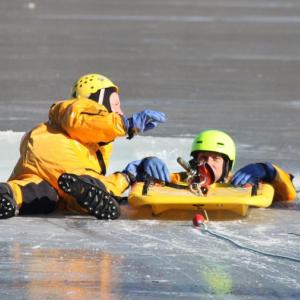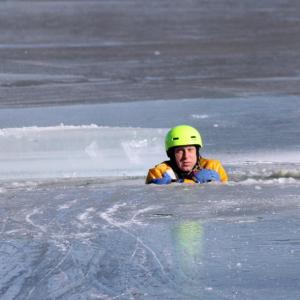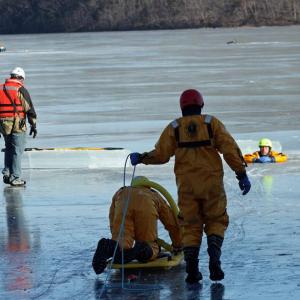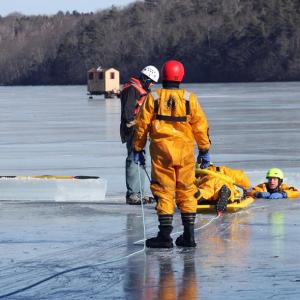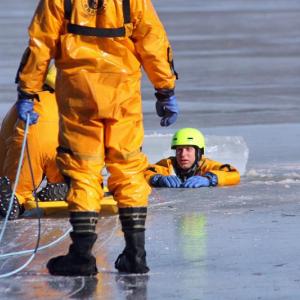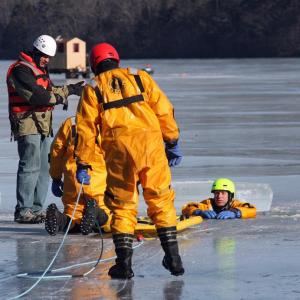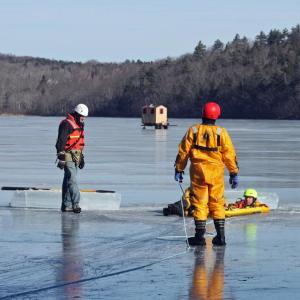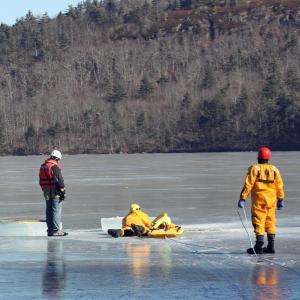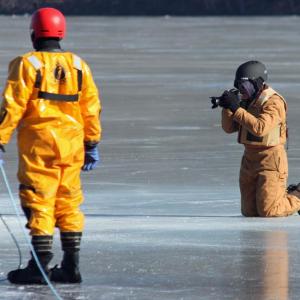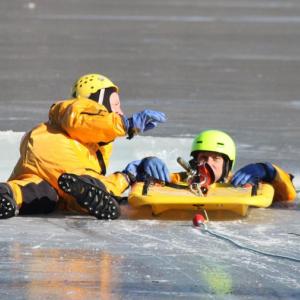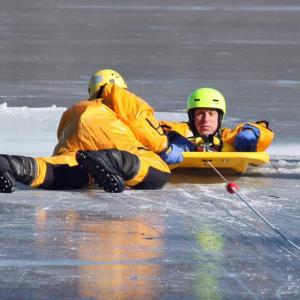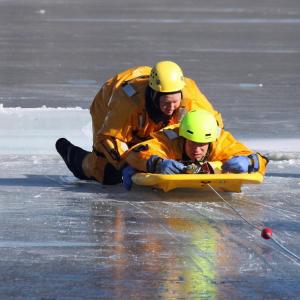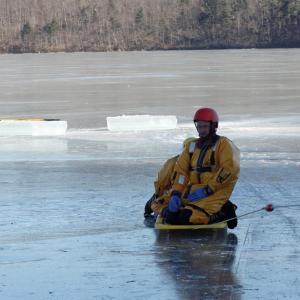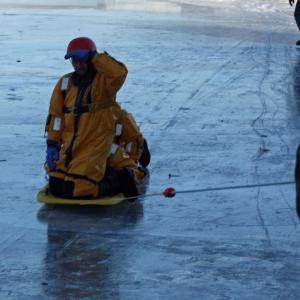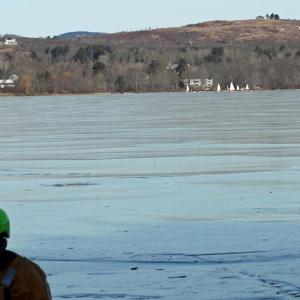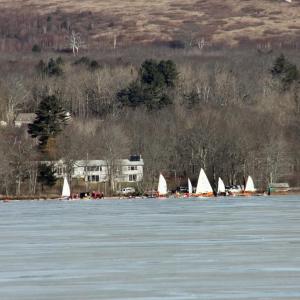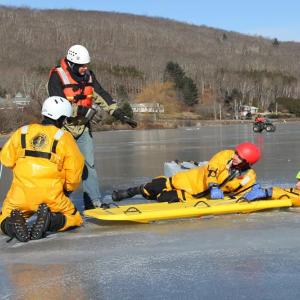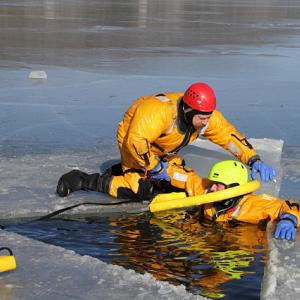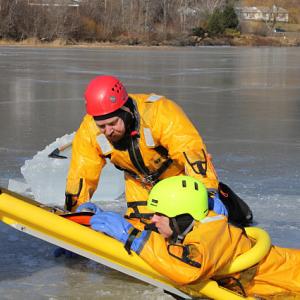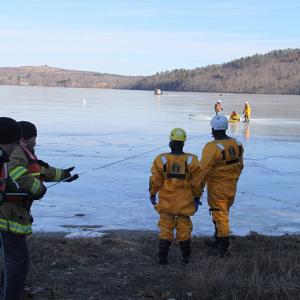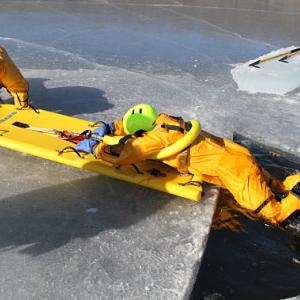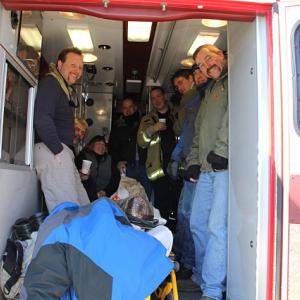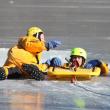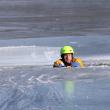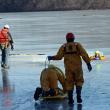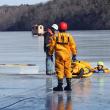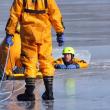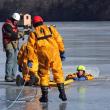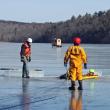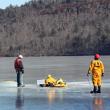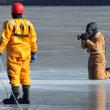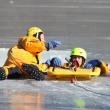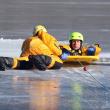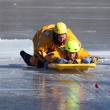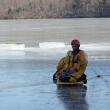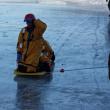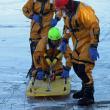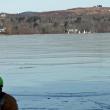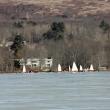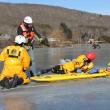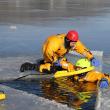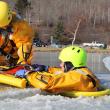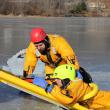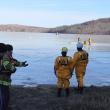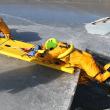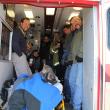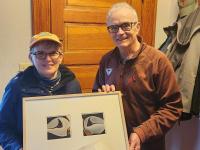Training for emergencies all in a day's work for Rockland responders
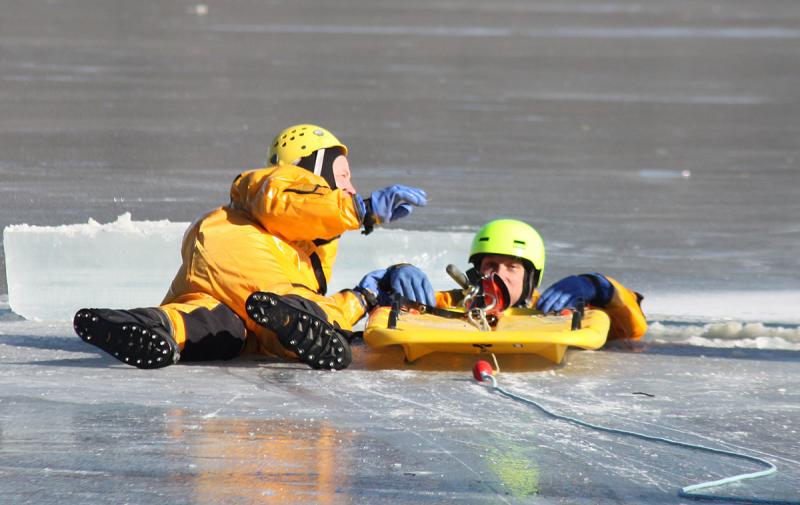 Saturday's training by Rockland Fire Department on Chickawaukie Pond involved cutting a hole in the ice and pulling a volunteer out of the frigid water, over and over again. (Photo by Holly S. Edwards)
Saturday's training by Rockland Fire Department on Chickawaukie Pond involved cutting a hole in the ice and pulling a volunteer out of the frigid water, over and over again. (Photo by Holly S. Edwards)
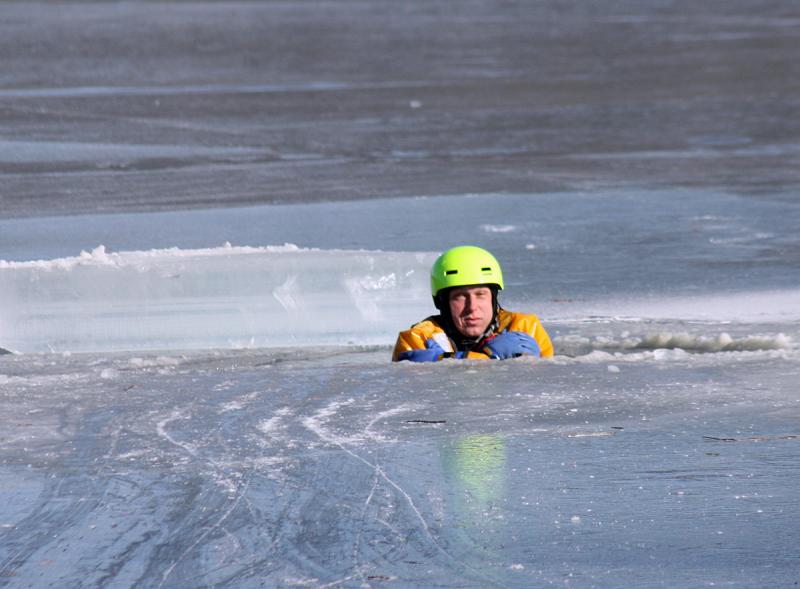 Rockland firefighter Mike Cole waits to be rescued during training on Chickawaukie Pond Saturday. (Photo by Holly S. Edwards)
Rockland firefighter Mike Cole waits to be rescued during training on Chickawaukie Pond Saturday. (Photo by Holly S. Edwards)
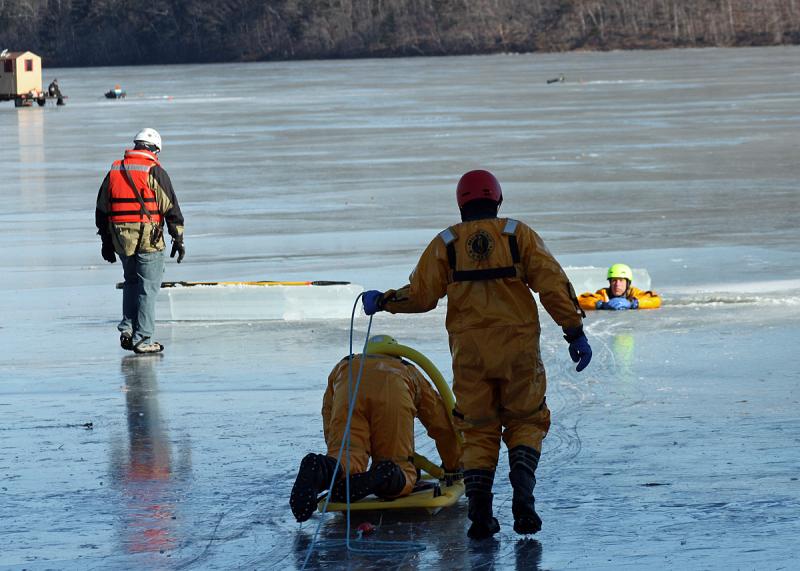 A team heads out onto the pond to make the rescue during training Saturday with an ice fisherman in the background. (Photo by Holly S. Edwards)
A team heads out onto the pond to make the rescue during training Saturday with an ice fisherman in the background. (Photo by Holly S. Edwards)
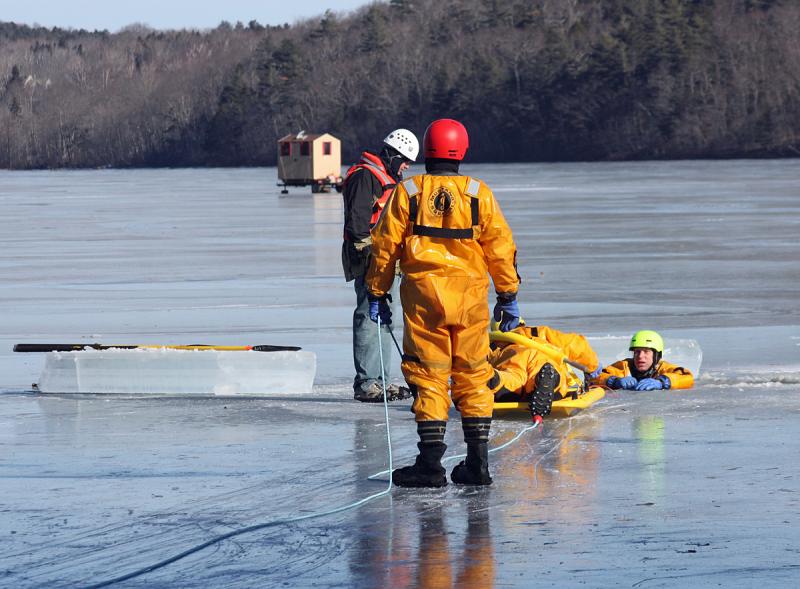 Firefighter Brian Sullivan makes his way atop the ice rescue sled toward Mike Cole, in the water. (Photo by Holly S. Edwards)
Firefighter Brian Sullivan makes his way atop the ice rescue sled toward Mike Cole, in the water. (Photo by Holly S. Edwards)
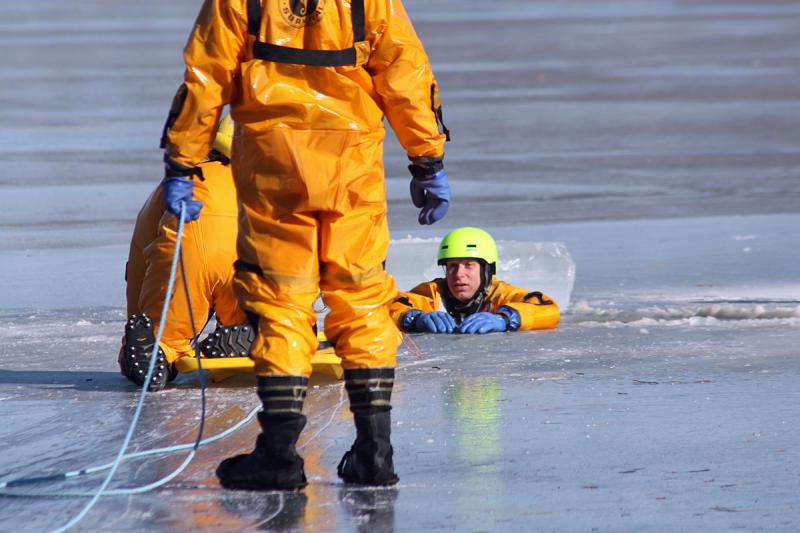 Firefighter Mike Cole is in the water as Brian Sullivan slides closer on the ice rescue sled. (Photo by Holly S. Edwards)
Firefighter Mike Cole is in the water as Brian Sullivan slides closer on the ice rescue sled. (Photo by Holly S. Edwards)
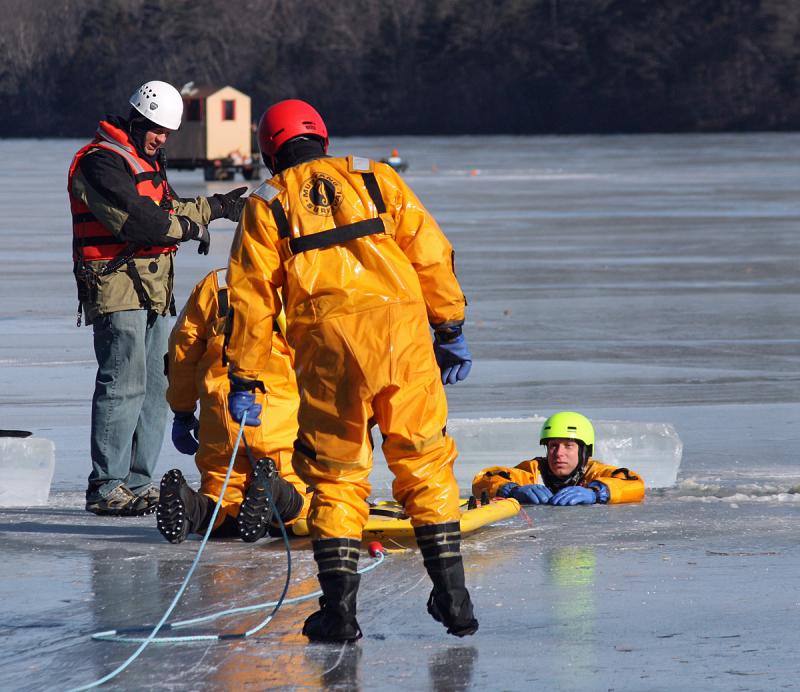 Rockland Fire Asst. Chief Adam Miceli, left, provides instruction during ice rescue training on Chickawaukie Pond in Rockland Saturday. (Photo by Holly S. Edwards)
Rockland Fire Asst. Chief Adam Miceli, left, provides instruction during ice rescue training on Chickawaukie Pond in Rockland Saturday. (Photo by Holly S. Edwards)
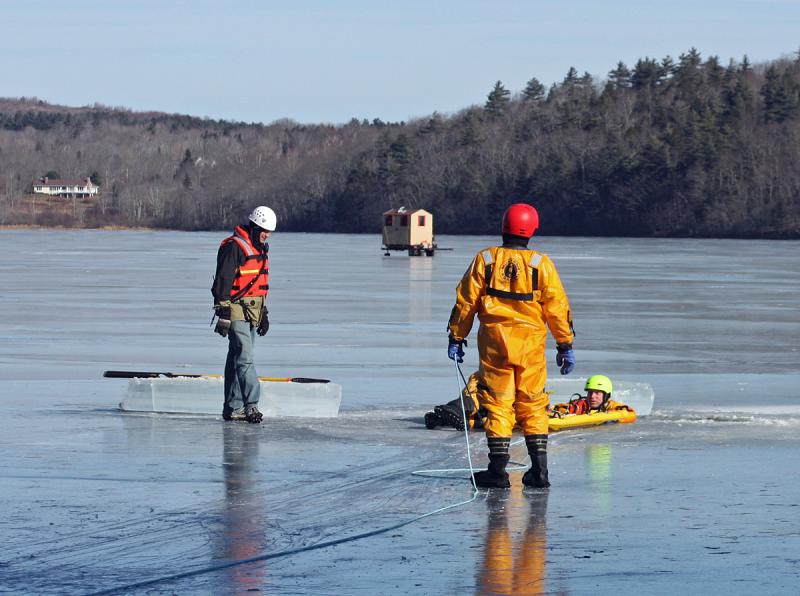
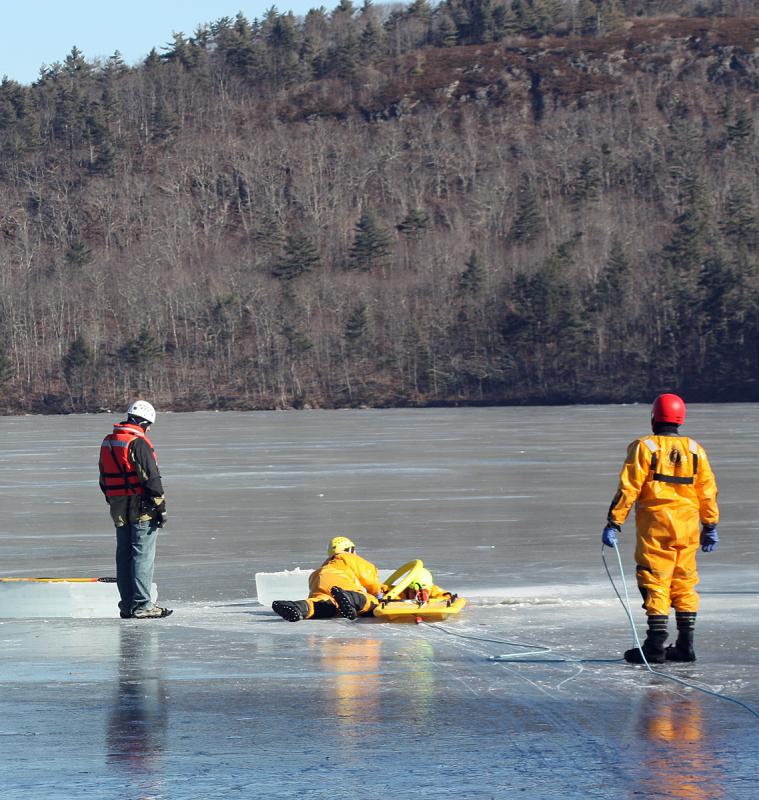 Firefighter Brian Sullivan moves the rescue sling onto Mike Cole, who is playing the victim in the frigid water. (Photo by Holly S. Edwards)
Firefighter Brian Sullivan moves the rescue sling onto Mike Cole, who is playing the victim in the frigid water. (Photo by Holly S. Edwards)
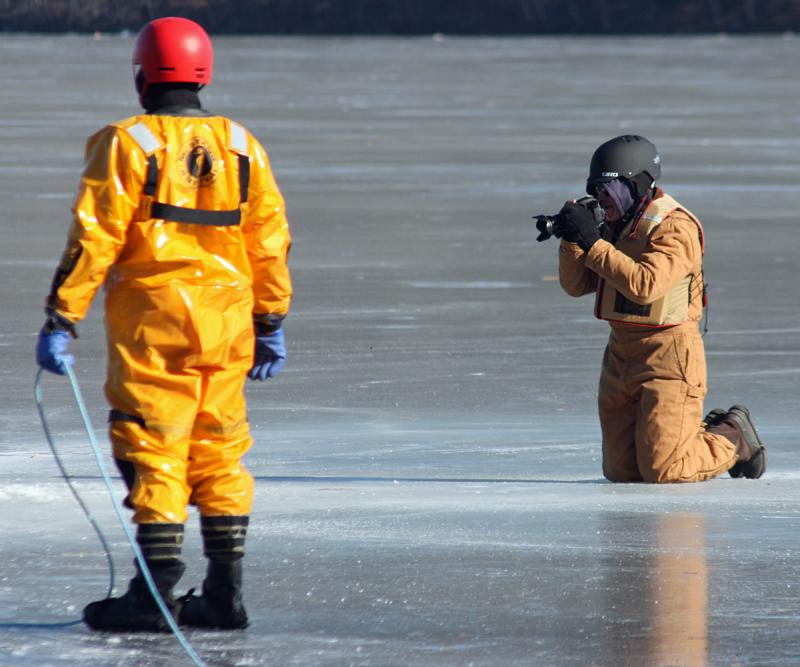 Rockland Fire Department photographer Alan Athearn chronicles the training for later review by the class. (Photo by Holly S. Edwards)
Rockland Fire Department photographer Alan Athearn chronicles the training for later review by the class. (Photo by Holly S. Edwards)
 Firefighter Brian Sullivan signals to the team on land to begin pulling the line to pull Mike Cole out of the water and onto the rescue sled. (Photo by Holly S. Edwards)
Firefighter Brian Sullivan signals to the team on land to begin pulling the line to pull Mike Cole out of the water and onto the rescue sled. (Photo by Holly S. Edwards)
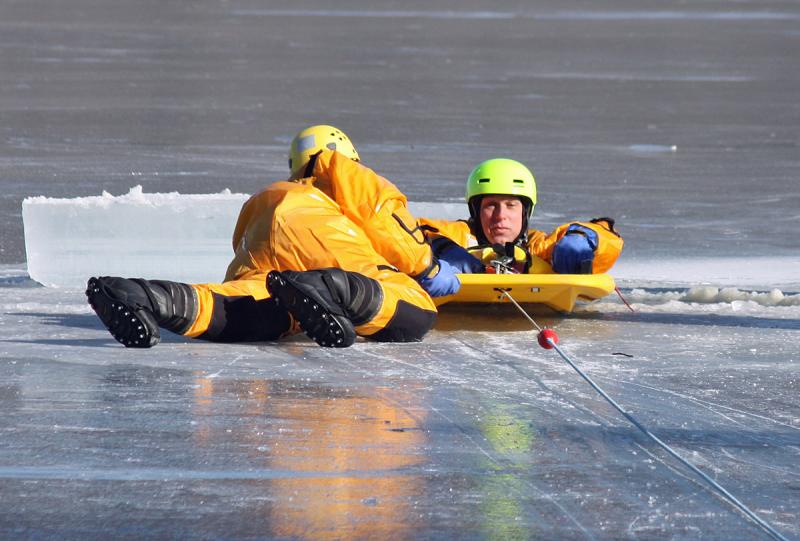 Firefighter Mike Cole is pulled onto the rescue sled during training Saturday on Chickawaukie Pond. (Photo by Holly S. Edwards)
Firefighter Mike Cole is pulled onto the rescue sled during training Saturday on Chickawaukie Pond. (Photo by Holly S. Edwards)
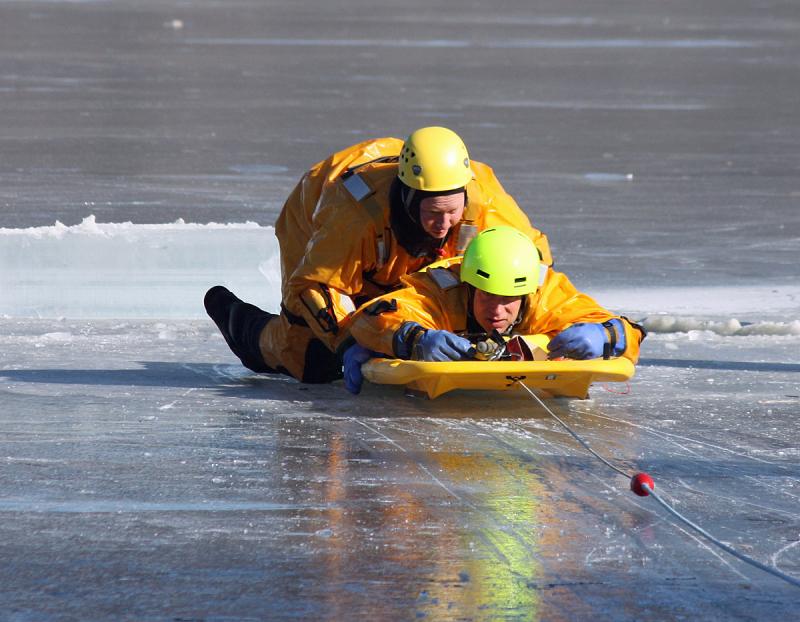 With the victim out of the water, he and one of the rescuers are pulled to safety on shore. (Photo by Holly S. Edwards)
With the victim out of the water, he and one of the rescuers are pulled to safety on shore. (Photo by Holly S. Edwards)
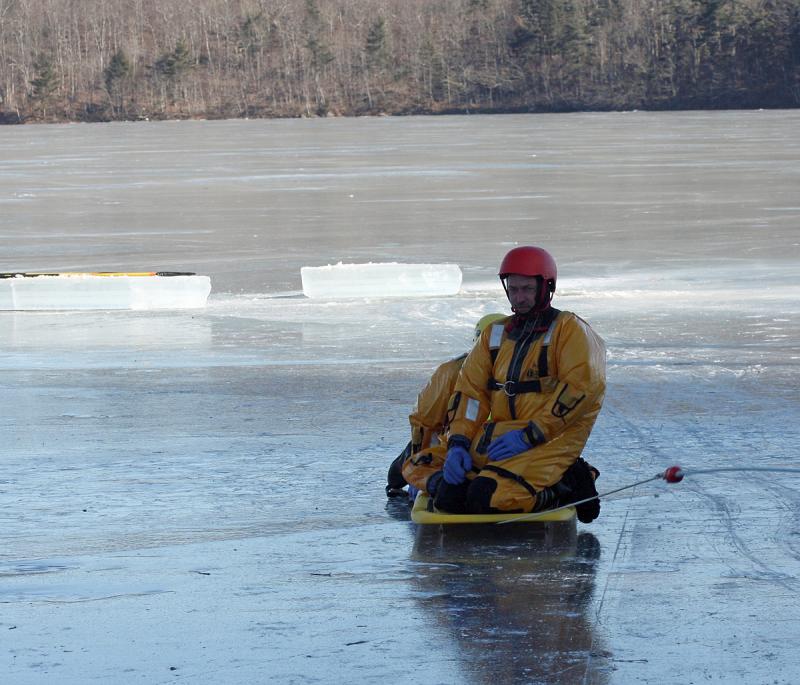 Second ice rescuer, firefighter Carl Anderson, climbs aboard the sled for the ride back to shore. (Photo by Holly S. Edwards)
Second ice rescuer, firefighter Carl Anderson, climbs aboard the sled for the ride back to shore. (Photo by Holly S. Edwards)
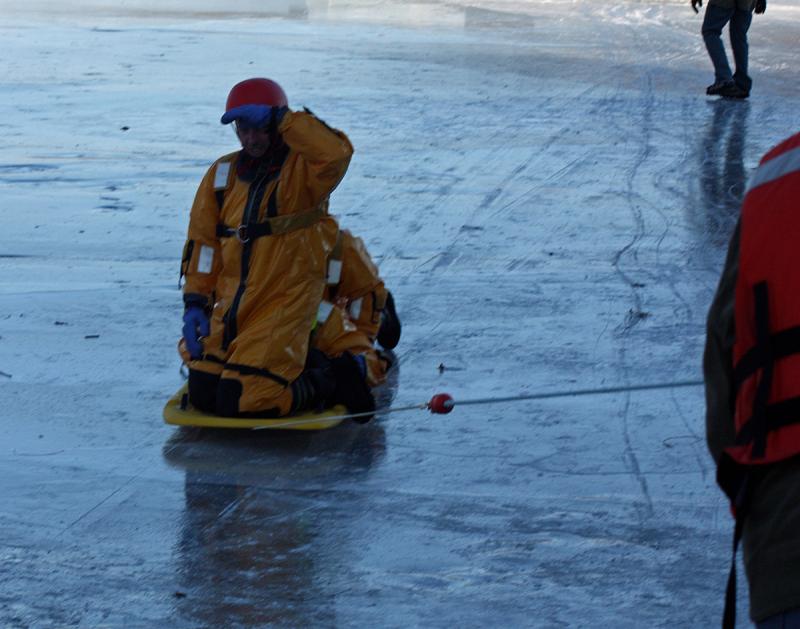 Saluting, ala George Washington crossing the Delaware River, the rescuers and victim are pulled back to shore off Chickawaukie Pond. (Photo by Holly S. Edwards)
Saluting, ala George Washington crossing the Delaware River, the rescuers and victim are pulled back to shore off Chickawaukie Pond. (Photo by Holly S. Edwards)
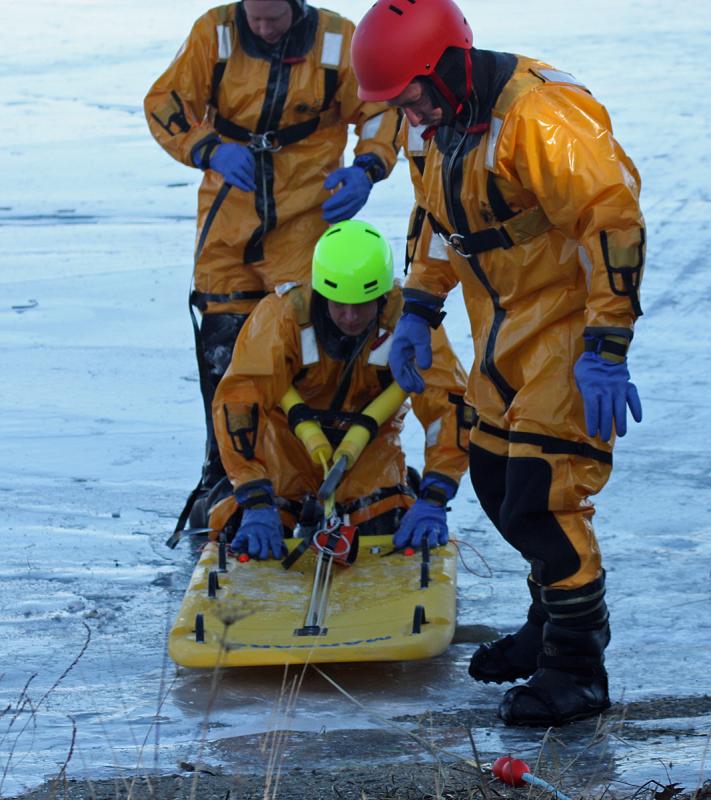 (Photo by Holly S. Edwards)
(Photo by Holly S. Edwards)
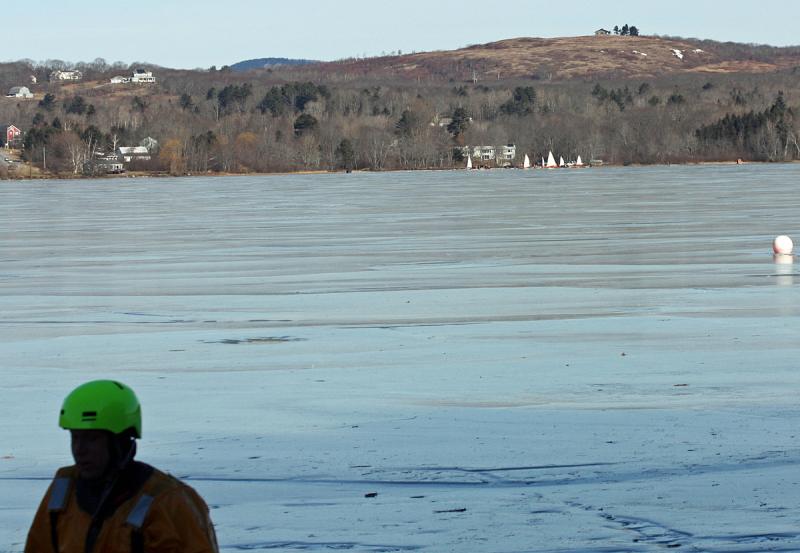 Near the end of Saturday's ice rescue training in Rockland, a flotilla of ice boats raises sails across Chickawaukie Pond. (Photo by Holly S. Edwards)
Near the end of Saturday's ice rescue training in Rockland, a flotilla of ice boats raises sails across Chickawaukie Pond. (Photo by Holly S. Edwards)
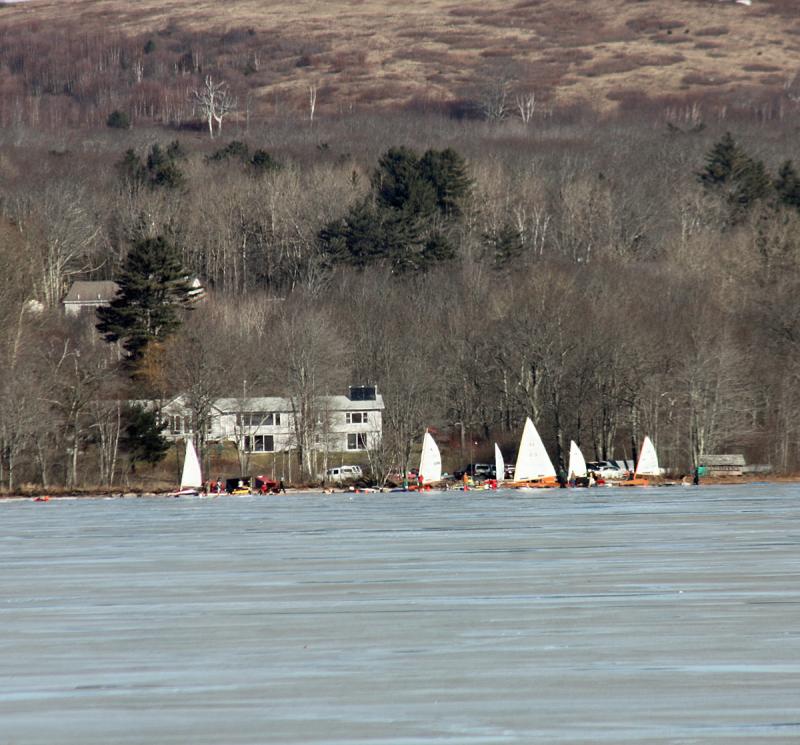 Last week's rain and thaw, followed by two nights of below-freezing temperatures made for perfect ice boat conditions on Chickawaukie Pond Saturday. (Photo by Holly S. Edwards)
Last week's rain and thaw, followed by two nights of below-freezing temperatures made for perfect ice boat conditions on Chickawaukie Pond Saturday. (Photo by Holly S. Edwards)
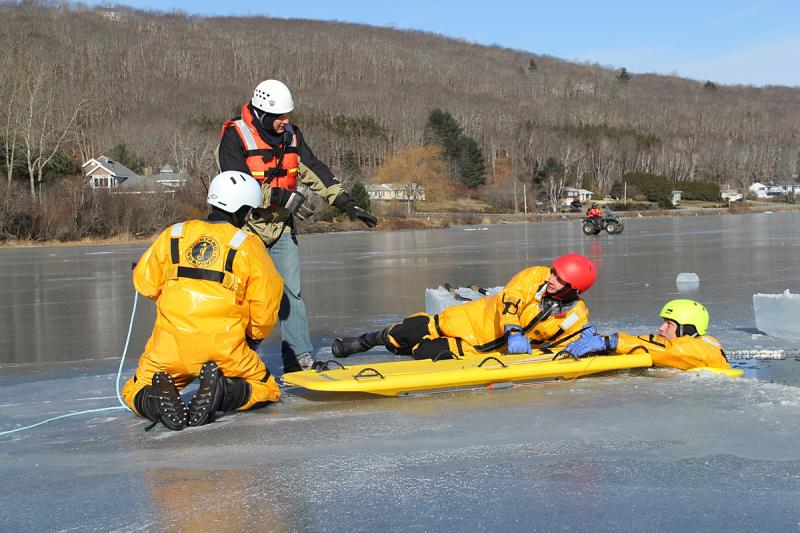 From left, Rockland firefighter Rodney Gibbs, Asst. Chief Adam Miceli, and firefighters Carl Anderson and Mike Cole. (Courtesy Rockland FD/by Alan Athearn)
From left, Rockland firefighter Rodney Gibbs, Asst. Chief Adam Miceli, and firefighters Carl Anderson and Mike Cole. (Courtesy Rockland FD/by Alan Athearn)
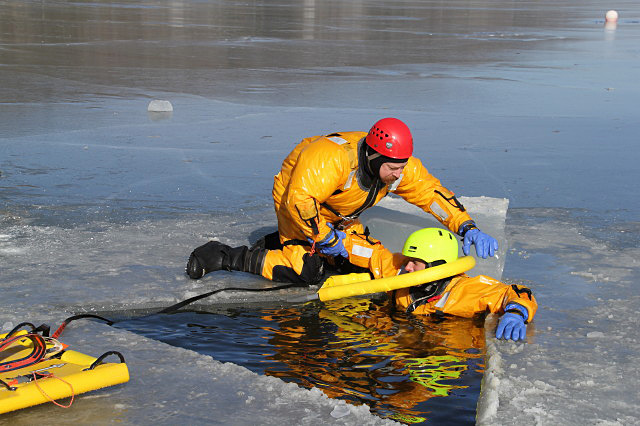 Firefighter Brian Sullivan puts the ring around Mike Cole in prepartion for getting him onto the sled, out of the water. (Courtesy Rockland FD/by Alan Athearn)
Firefighter Brian Sullivan puts the ring around Mike Cole in prepartion for getting him onto the sled, out of the water. (Courtesy Rockland FD/by Alan Athearn)
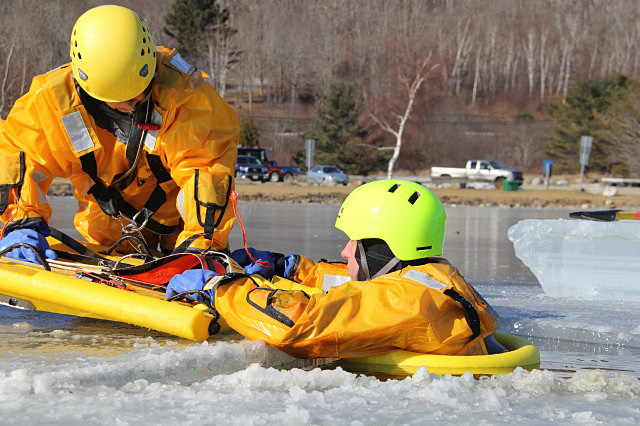 (Courtesy Rockland FD/by Alan Athearn)
(Courtesy Rockland FD/by Alan Athearn)
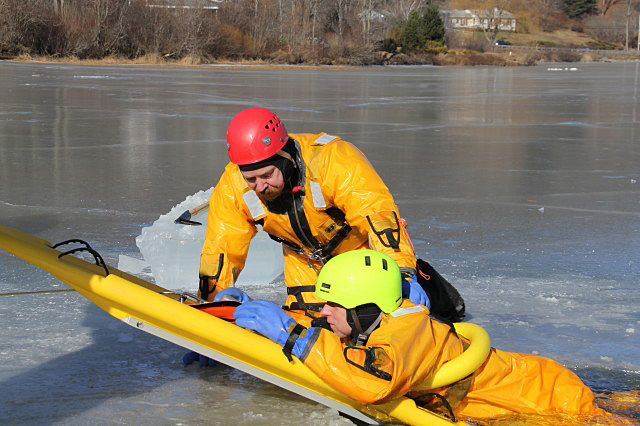 A team on land pulls the line attached to the ring, which then pulls the victim out of the water and onto the rescue sled. (Courtesy Rockland FD/by Alan Athearn)
A team on land pulls the line attached to the ring, which then pulls the victim out of the water and onto the rescue sled. (Courtesy Rockland FD/by Alan Athearn)
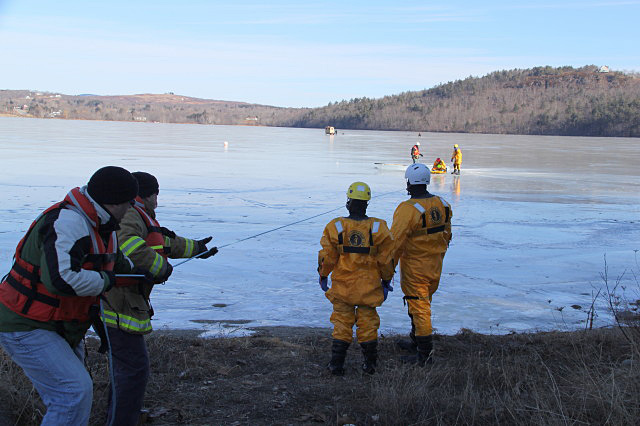 The line-pulling team on shore. (Courtesy Rockland FD/by Alan Athearn)
The line-pulling team on shore. (Courtesy Rockland FD/by Alan Athearn)
 Pulling the line from shore and the victim slips out of the water, ever so gracefully. (Courtesy Rockland FD/by Alan Athearn)
Pulling the line from shore and the victim slips out of the water, ever so gracefully. (Courtesy Rockland FD/by Alan Athearn)
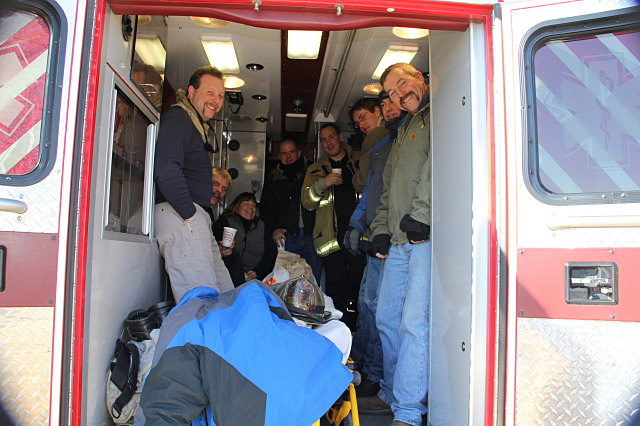 At least one of Rockland's ambulances was used for rehab and getting warm during the ice training at Chickawaukie Pond Saturday. (Courtesy Rockland FD/by Alan Athearn)
At least one of Rockland's ambulances was used for rehab and getting warm during the ice training at Chickawaukie Pond Saturday. (Courtesy Rockland FD/by Alan Athearn)
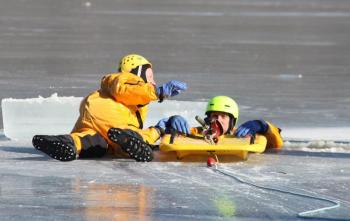 Saturday's training by Rockland Fire Department on Chickawaukie Pond involved cutting a hole in the ice and pulling a volunteer out of the frigid water, over and over again. (Photo by Holly S. Edwards)
Saturday's training by Rockland Fire Department on Chickawaukie Pond involved cutting a hole in the ice and pulling a volunteer out of the frigid water, over and over again. (Photo by Holly S. Edwards)
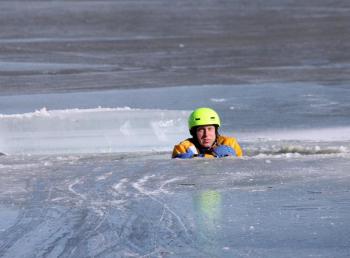 Rockland firefighter Mike Cole waits to be rescued during training on Chickawaukie Pond Saturday. (Photo by Holly S. Edwards)
Rockland firefighter Mike Cole waits to be rescued during training on Chickawaukie Pond Saturday. (Photo by Holly S. Edwards)
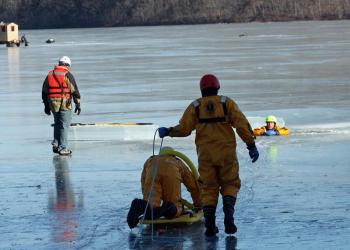 A team heads out onto the pond to make the rescue during training Saturday with an ice fisherman in the background. (Photo by Holly S. Edwards)
A team heads out onto the pond to make the rescue during training Saturday with an ice fisherman in the background. (Photo by Holly S. Edwards)
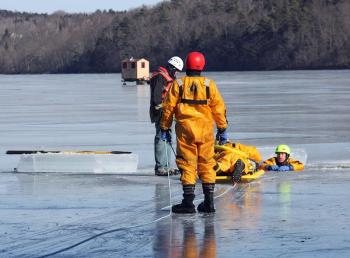 Firefighter Brian Sullivan makes his way atop the ice rescue sled toward Mike Cole, in the water. (Photo by Holly S. Edwards)
Firefighter Brian Sullivan makes his way atop the ice rescue sled toward Mike Cole, in the water. (Photo by Holly S. Edwards)
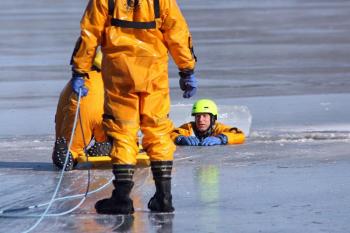 Firefighter Mike Cole is in the water as Brian Sullivan slides closer on the ice rescue sled. (Photo by Holly S. Edwards)
Firefighter Mike Cole is in the water as Brian Sullivan slides closer on the ice rescue sled. (Photo by Holly S. Edwards)
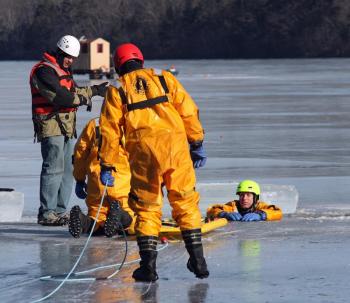 Rockland Fire Asst. Chief Adam Miceli, left, provides instruction during ice rescue training on Chickawaukie Pond in Rockland Saturday. (Photo by Holly S. Edwards)
Rockland Fire Asst. Chief Adam Miceli, left, provides instruction during ice rescue training on Chickawaukie Pond in Rockland Saturday. (Photo by Holly S. Edwards)
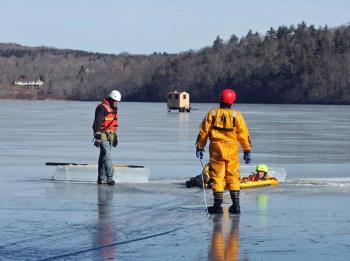
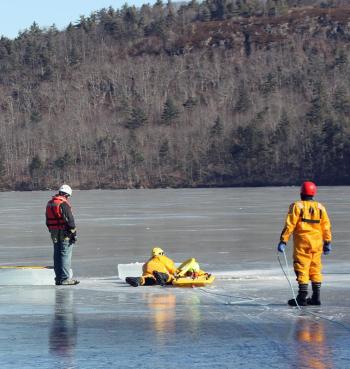 Firefighter Brian Sullivan moves the rescue sling onto Mike Cole, who is playing the victim in the frigid water. (Photo by Holly S. Edwards)
Firefighter Brian Sullivan moves the rescue sling onto Mike Cole, who is playing the victim in the frigid water. (Photo by Holly S. Edwards)
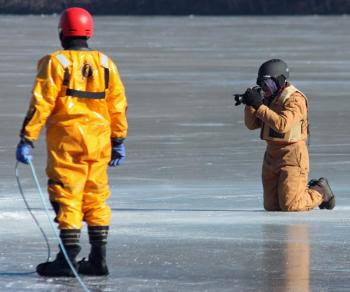 Rockland Fire Department photographer Alan Athearn chronicles the training for later review by the class. (Photo by Holly S. Edwards)
Rockland Fire Department photographer Alan Athearn chronicles the training for later review by the class. (Photo by Holly S. Edwards)
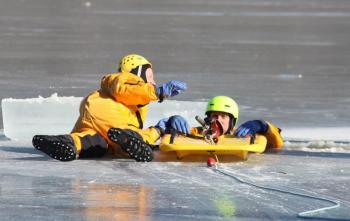 Firefighter Brian Sullivan signals to the team on land to begin pulling the line to pull Mike Cole out of the water and onto the rescue sled. (Photo by Holly S. Edwards)
Firefighter Brian Sullivan signals to the team on land to begin pulling the line to pull Mike Cole out of the water and onto the rescue sled. (Photo by Holly S. Edwards)
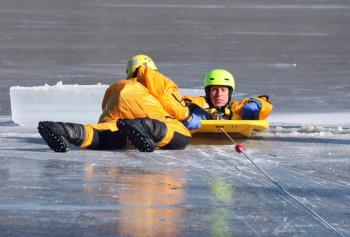 Firefighter Mike Cole is pulled onto the rescue sled during training Saturday on Chickawaukie Pond. (Photo by Holly S. Edwards)
Firefighter Mike Cole is pulled onto the rescue sled during training Saturday on Chickawaukie Pond. (Photo by Holly S. Edwards)
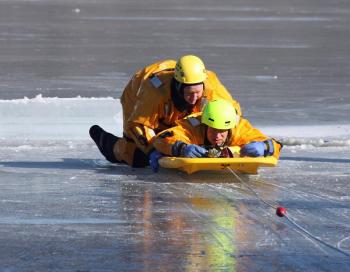 With the victim out of the water, he and one of the rescuers are pulled to safety on shore. (Photo by Holly S. Edwards)
With the victim out of the water, he and one of the rescuers are pulled to safety on shore. (Photo by Holly S. Edwards)
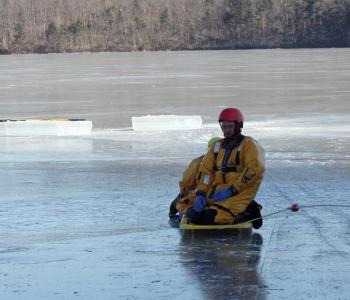 Second ice rescuer, firefighter Carl Anderson, climbs aboard the sled for the ride back to shore. (Photo by Holly S. Edwards)
Second ice rescuer, firefighter Carl Anderson, climbs aboard the sled for the ride back to shore. (Photo by Holly S. Edwards)
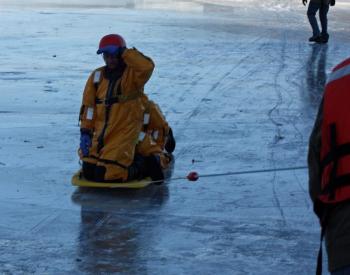 Saluting, ala George Washington crossing the Delaware River, the rescuers and victim are pulled back to shore off Chickawaukie Pond. (Photo by Holly S. Edwards)
Saluting, ala George Washington crossing the Delaware River, the rescuers and victim are pulled back to shore off Chickawaukie Pond. (Photo by Holly S. Edwards)
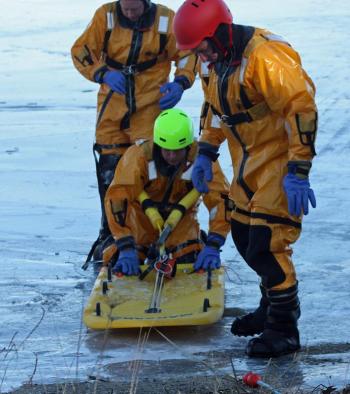 (Photo by Holly S. Edwards)
(Photo by Holly S. Edwards)
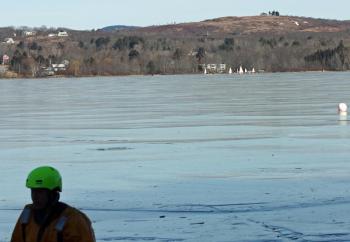 Near the end of Saturday's ice rescue training in Rockland, a flotilla of ice boats raises sails across Chickawaukie Pond. (Photo by Holly S. Edwards)
Near the end of Saturday's ice rescue training in Rockland, a flotilla of ice boats raises sails across Chickawaukie Pond. (Photo by Holly S. Edwards)
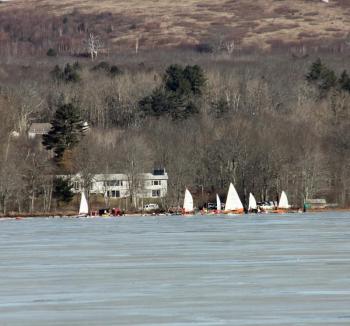 Last week's rain and thaw, followed by two nights of below-freezing temperatures made for perfect ice boat conditions on Chickawaukie Pond Saturday. (Photo by Holly S. Edwards)
Last week's rain and thaw, followed by two nights of below-freezing temperatures made for perfect ice boat conditions on Chickawaukie Pond Saturday. (Photo by Holly S. Edwards)
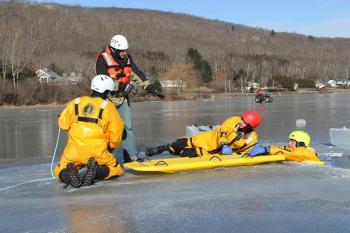 From left, Rockland firefighter Rodney Gibbs, Asst. Chief Adam Miceli, and firefighters Carl Anderson and Mike Cole. (Courtesy Rockland FD/by Alan Athearn)
From left, Rockland firefighter Rodney Gibbs, Asst. Chief Adam Miceli, and firefighters Carl Anderson and Mike Cole. (Courtesy Rockland FD/by Alan Athearn)
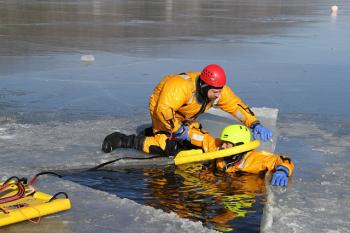 Firefighter Brian Sullivan puts the ring around Mike Cole in prepartion for getting him onto the sled, out of the water. (Courtesy Rockland FD/by Alan Athearn)
Firefighter Brian Sullivan puts the ring around Mike Cole in prepartion for getting him onto the sled, out of the water. (Courtesy Rockland FD/by Alan Athearn)
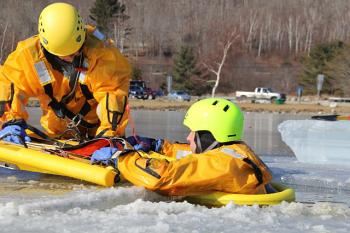 (Courtesy Rockland FD/by Alan Athearn)
(Courtesy Rockland FD/by Alan Athearn)
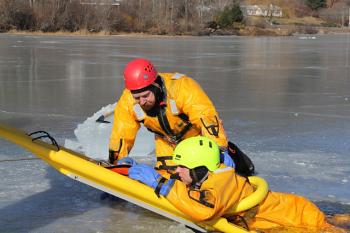 A team on land pulls the line attached to the ring, which then pulls the victim out of the water and onto the rescue sled. (Courtesy Rockland FD/by Alan Athearn)
A team on land pulls the line attached to the ring, which then pulls the victim out of the water and onto the rescue sled. (Courtesy Rockland FD/by Alan Athearn)
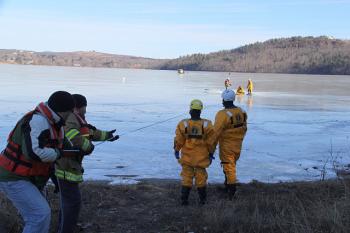 The line-pulling team on shore. (Courtesy Rockland FD/by Alan Athearn)
The line-pulling team on shore. (Courtesy Rockland FD/by Alan Athearn)
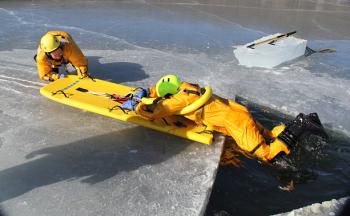 Pulling the line from shore and the victim slips out of the water, ever so gracefully. (Courtesy Rockland FD/by Alan Athearn)
Pulling the line from shore and the victim slips out of the water, ever so gracefully. (Courtesy Rockland FD/by Alan Athearn)
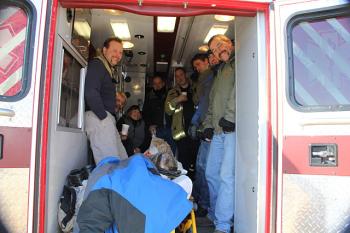 At least one of Rockland's ambulances was used for rehab and getting warm during the ice training at Chickawaukie Pond Saturday. (Courtesy Rockland FD/by Alan Athearn)
At least one of Rockland's ambulances was used for rehab and getting warm during the ice training at Chickawaukie Pond Saturday. (Courtesy Rockland FD/by Alan Athearn)
ROCKLAND — A cloudless sky and bright sunshine did little to ease the cold temperature around Chickawaukie Pond, where Rockland first responders were learning and practicing ice rescue skills Saturday.
True ice emergencies don't happen often in the Midcoast, but they can be deadly when they do and emergency responders train for them annually.
Chickawaukie Pond was the site of a tragic ice boating accident that claimed the life of 52-year-old Mark McClellan of Rockland Dec. 20, 2009. McClellan was ice boating alone on that snowy day when he and his boat plunged through the ice and someone on shore heard his cries for help. Using many of the techniques that were practiced Saturday, Rockland and Rockport firefighters used a commandeered boat tethered by a line to shore to reach McClellan, who struggled in the water for more than an hour before being pulled to shore.
Unlike the 13-inch-thick ice rescuers were practicing on Feb. 2, the thickness of the ice on Dec. 20, 2009, wasn't known. In addition, the location where McClellan went in wasn't likely to be as stable, since he and his boat either encountered an open area or created one in a weak spot.
But McClellan's accident was exactly why emergency responders were gathered on the same pond last weekend, practicing their techniques.
Rockland Fire Department's entire emergency fleet, including its engines, three ambulances and various utility vehicles, was assembled at the Chickie Beach parking area for a couple of hours around noon Saturday. They weren't the only ones braving the cold though. Beyond them an ice fishermen could be seen patiently awaiting a nibble on a line and a tip-up, a woman was tentatively gliding on ice skates across the pond, on the opposite shore, a contingent of ice boats was raising sails.
For the group in the bright orange Mustang Survival suits, this was serious business, even if they did occasionally crack jokes to ward off the chill and trepidation of an impending dip in the freezing water.
Yards offshore, an approximately 4-foot-square hole had been cut through the 12- to 13-inch-thick ice. In turn, a firefighter in one of those survival suits slipped into the hole and floated in the water while a team of two walked onto the ice with gear to "rescue" them.
Everyone who went onto the ice used crampons, or ice "creepers," to keep from slipping and falling, a serious danger for rescuers. According to the operation's Standard Operating Guideline, maintaining stable footing was as important as staying warm. Being out on ice offers limited protection from the cold and wind, and snow cover can limit one's ability to see what is underfoot.
Proper equipment, worn properly, is a key to staying safe when venturing onto frozen lakes and ponds, especially when the reason for being out there is failure of the ice to "carry the load subjected to it."
Saturday's training began back at the station, where the rescuers reviewed the Standard Operating Guideline. The SOG covered the course of action beginning with the receipt of the call for "help." After obtaining as much information about the nature of the emergency as possible (including number of victims, location, best access point, etc.), Rockland firefighters learned who would generally be assigned where, and by whom.
They reviewed what equipment was needed for the call, where to find it and even which vehicle to put it on before leaving the station. Equipment for an ice rescue includes a MARSARS sled with a rescue ring, a rescue line reel and Mustang Ice Suits.
The ice rescue sled is used for rapid intervention. It is lightweight and buoyant, provides even weight distribution and allows a safer-distance rescue of a panicking victim. The hull of the sled is also designed to minimize friction and provide for a quicker rescue speed across the ice.
Using the sled and under the direction of Rockland Asst. Fire Chief Adam Miceli, a floating firefighter "victim" was approached by a pair of suited rescuers, one traveling out atop the rescue sled and the other walking 15-20 feet behind him. Sliding the sled toward the victim, they were instructed to slip the rescue ring over their head and they were then pulled out of the water and onto the sled. The pulling was done by a team of two on land using a long line attached to the sled.
Had the "victim" been unconscious, protocol is for both rescuers to work together to extricate the victim from the water. But when the victim is conscious, and able, they are encouraged to help with their extrication from the water to keep the rescuer(s) from becoming victims too.
Two by two, the group took turns venturing onto the ice to make the rescue. And one by one, the firefighters each took a dip in the pond Saturday.
Everybody went home safe, and a little wiser.
Editorial Director Holly S. Edwards can be reached by email at hollyedwards@penbaypilot.com or by calling 207-706-6655.
Event Date
Address
Chickawaukie Pond
Rockland, ME 04841
United States

